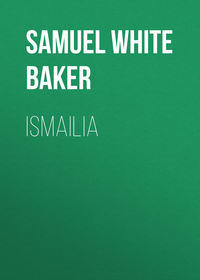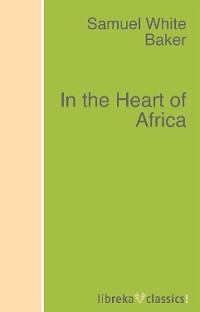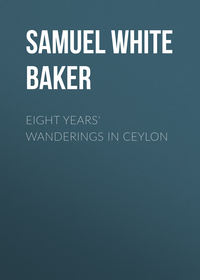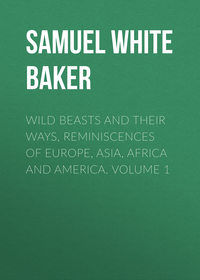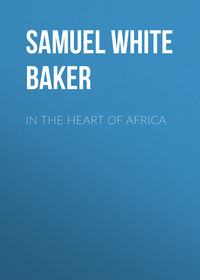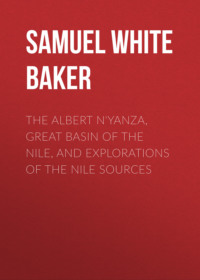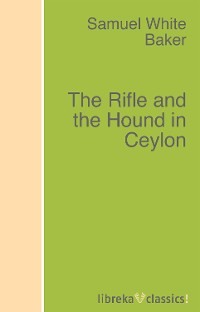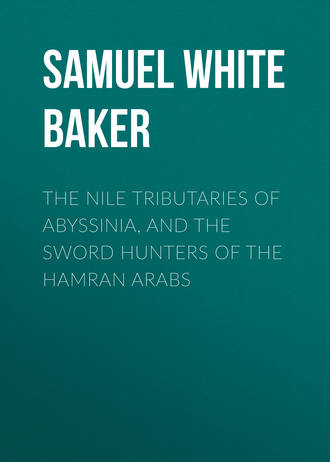 полная версия
полная версияThe Nile Tributaries of Abyssinia, and the Sword Hunters of the Hamran Arabs
The African elephant is about a foot higher than the average of the Indian species. The bulls of the former are about ten feet six inches at the shoulder; the females are between nine feet and nine feet six. Of course there are many bulls that exceed this height, and I have seen some few of both species that might equal twelve feet, but those are the exceptional Goliaths.
The tusks of elephants vary considerably, and there appears to be no rule to determine a reason for their size and quality. In Abyssinia and Taka, a single tusk of a bull elephant seldom exceeds forty pounds, nor do they average more than twenty-five, but in Central Africa they average about forty, and I have seen them upwards of one hundred and fifty pounds. The largest that I have had the good fortune to bag was eighty pounds; the fellow-tusk was slightly below seventy. Elephants invariably use one tusk in preference, as we use the right hand; thus it is difficult to obtain an exact pair, as the Hadam (or servant), as the Arabs call the working tusk, is generally much worn. The African elephant is a more decided tree-feeder than the Indian, and the destruction committed by a large herd of such animals when feeding in a mimosa forest is extraordinary; they deliberately march forward, and uproot or break down every tree that excites their appetite. The mimosas are generally from sixteen to twenty feet high, and, having no tap-root, they are easily overturned by the tusks of the elephants, which are driven like crowbars beneath the roots, and used as levers, in which rough labour they are frequently broken. Upon the overthrow of a tree, the elephants eat the roots and leaves, and strip the bark from the branches by grasping them with their rough trunks.
The African elephant is equally docile as the Indian, when domesticated, but we have no account of a negro tribe that has ever tamed one of these sagacious animals: their only maxim is "kill and eat." Although the flesh of the elephant is extremely coarse, the foot and trunk are excellent, if properly cooked. A hole should be dug in the earth, about four feet deep, and two feet six inches in diameter, the sides of which should be perpendicular; in this a large fire should be lighted, and kept burning for four or five hours with a continual supply of wood, so that the walls become red-hot. At the expiration of the blaze, the foot should be laid upon the glowing embers, and the hole covered closely with thick pieces of green wood laid parallel together to form a ceiling; this should be covered with wet grass, and the whole plastered with mud, and stamped tightly down to retain the heat. Upon the mud, a quantity of earth should be heaped, and the oven should not be opened for thirty hours, or more. At the expiration of that time, the foot will be perfectly baked, and the sole will separate like a shoe, and expose a delicate substance that, with a little oil and vinegar, together with an allowance of pepper and salt, is a delicious dish that will feed about fifty men.
The Arabs are particularly fond of elephant's flesh, as it is generally fat and juicy. I have frequently used the fat of the animal for cooking, but it should be taken from the body without delay; as, if left for a few hours, it partakes of the peculiar smell of the elephant, which no amount of boiling will overcome. The boiling of fat for preservation requires much care, as it should attain so great a heat that a few drops of water thrown upon the surface will hiss and evaporate as though cast upon molten metal; it should then be strained, and, when tolerably cool, be poured into vessels, and secured. No salt is necessary, provided it is thoroughly boiled. When an animal is killed, the flesh should be properly dried, before boiling down, otherwise the fat will not melt thoroughly, as it will be combined with the water contained in the body. The fat should be separated as well as possible from the meat; it should then be hung in long strips upon a line and exposed in the sun to dry; when nearly dried, it should be cut into pieces of about two inches in length, and placed in a large vessel over a brisk fire, and kept constantly stirred. As the fat boils out from the meat, the residue should be taken out with a pierced ladle; this, when cool, should be carefully preserved in leathern bags. This is called by the Arabs "reveet," a supply of which is most valuable, as a quantity can be served out to each man during a long march when there is no time to halt; it can be eaten without bread, and it is extremely nourishing. With a good supply of reveet in store, the traveller need not be nervous about his dinner. Dried meat should also be kept in large quantities; the best is that of the giraffe and hippopotamus, but there is some care required in preparing the first quality. It should be cut from portions of the animals as free as possible from sinews, and should be arranged in long thin strips of the diameter of about an inch and a quarter; these ribbon-like morsels should be hung in the shade. When nearly dry, they should be taken down, and laid upon a flat rock, upon which they should be well beaten with a stone, or club of hard wood; this breaks the fibre; after which they should be hung up and thoroughly dried, care being taken that the flesh is not exposed to the sun. If many flies are present, the flesh should be protected by the smoke of fires lighted to windward.
When meat is thus carefully prepared, it can be used in various ways, and is exceedingly palatable; if pounded into small pieces like coarse sawdust, it forms an admirable material for curry and rice. The Arabs make a first-class dish of melach, by mixing a quantity of pounded dried meat with a thick porridge of dhurra meal, floating in a soup of barmian (waker), with onions, salt, and red peppers; this is an admirable thing if the party is pressed for time (if not too hot, as a large quantity can be eaten with great expedition. As the Arabs are nomadic, they have a few simple but effective arrangements for food during the journey. For a fortnight preparatory to an expedition, the women are busily engaged in manufacturing a supply of abrey. This is made in several methods: there is the sour, and the sweet abrey; the former is made of highly-fermented dhurra paste that has turned intensely acid; this is formed into thin wafers, about sixteen inches in diameter, upon the doka or hearth, and dried in the sun until the abrey has become perfectly crisp; the wafers are then broken up with the hands, and packed in bags. There is no drink more refreshing than water poured over a handful of sour abrey, and allowed to stand for half an hour; it becomes pleasantly acid, and is superior to lemonade. The residue is eaten by the Arabs: thus the abrey supplies both meat and drink. The finest quality of sweet abrey is a very delicate affair; the flour of dhurra must be well sifted; it is then mixed with milk instead of water, and, without fermenting, it is formed into thin wafers similar to those eaten with ice-creams in this country, but extremely large; these are dried in the sun, and crushed like the sour abrey; they will keep for months if kept dry in a leathern bag. A handful of sweet abrey steeped in a bowl of hot milk, with a little honey, is a luxurious breakfast; nothing can be more delicious, and it can be prepared in a few minutes during the short halt upon a journey. With a good supply of abrey and dried meat, the commissariat arrangements are wonderfully simplified, and a party can march a great distance without much heavy baggage to impede their movements.
The flesh that is the least adapted for drying is that of the buffalo (Bos Caffer), which is exceedingly tough and coarse. There are two species of the Bos Caffer in Abyssinia and Central Africa, which, similar in general appearance, differ in the horns; that which resembles the true Bos Caffer of South Africa has very massive convex horns that unite in front, and completely cover the forehead as with a shield; the other variety has massive, but perfectly flat horns of great breadth, that do not quite unite over the os frontis, although nearly so; the flatness of the horns continues in a rough surface, somewhat resembling the bark of a tree, for about twelve inches; the horns then become round, and curve gracefully inwards, like those of the convex species. Buffaloes are very dangerous and determined animals; but, although more accidents occur in hunting these than any other variety of game, I cannot admit that they are such formidable opponents as the elephant and black rhinoceros; they are so much more numerous than the latter, that they are more frequently encountered: hence the casualties.
A buffalo can always be killed with a No. 10 rifle and six drachms of powder when charging, if the hunter will only wait coolly until it is so close that he cannot miss the forehead; but the same rifle will fail against an African elephant, or a black rhinoceros, as the horns of the latter animal effectually protect the brain from a front shot. I have killed some hundreds of buffaloes, and, although in many cases they have been unpleasantly near, the rifle has always won the day. There cannot be a more convenient size than No. 10 for a double rifle, for large game. This will throw a conical projectile of three ounces, with seven drachms of powder. Although a breechloader is a luxury, I would not have more than a pair of such rifles in an expedition in a wild country, as they would require more care in a damp climate than the servants would be likely to bestow upon them, and the ammunition would be a great drawback. This should be divided into packets of ten cartridges each, which should be rolled up in flannel and hermetically sealed in separate tin canisters. Thus arranged, they would be impervious to damp, and might be carried conveniently. But I should decidedly provide myself with four double-barrelled muzzle-loading No. 10's as my regular battery; that, if first class, would never get out of order. Nothing gives such confidence to the gun-bearers as the fact of their rifles being good slayers, and they quickly learn to take a pride in their weapons, and to strive in the race to hand the spare rifles. Dust storms, such as I have constantly witnessed in Africa, would be terrible enemies to breech-loaders, as the hard sand, by grating in the joints, would wear away the metal, and destroy the exactness of the fittings.
A small handy double rifle, such as my little Fletcher 24, not exceeding eight pounds and a half, is very necessary, as it should seldom be out of the hand. Such a rifle should be a breech-loader, as the advantage of loading quickly while on horseback is incalculable. Hunting-knives should be of soft steel, similar to butchers' knives; but one principal knife to be worn daily should be of harder steel, with the back of the blade roughed and case-hardened like a butcher's steel, for sharpening other knives when required.
All boxes for rough travelling should be made of strong metal, japanned. These are a great comfort, as they are proof both against insects and weather, and can be towed with their contents across a river.
Travelling is now so generally understood, that it is hardly necessary to give any instructions for the exploration of wild countries; but a few hints may be acceptable upon points that, although not absolutely essential, tend much to the comfort of the traveller. A couple of large carriage umbrellas with double lining, with small rings fixed to the extremities of the ribs, and a spike similar to that of a fishing-rod to screw into the handle, will form an instantaneous shelter from sun or rain during a halt on the march, as a few strings from the rings will secure it from the wind, if pegged to the ground. Waterproof calico sheeting should be taken in large quantities, and a tarpaulin to protect the baggage during the night's bivouac. No vulcanised India-rubber should be employed in tropical climates; it rots, and becomes useless. A quart syringe for injecting brine into fresh meat is very necessary. In hot climates, the centre of the joint will decompose before the salt can penetrate to the interior, but an injecting syringe will thoroughly preserve the meat in a few minutes. A few powerful fox-traps are useful for catching night-game in countries where there is no large game for the rifle: also wire is useful for making springs.
Several sticks of Indian-ink are convenient, as sufficient can be rubbed up in a few moments to write up the note-book during the march. All journals and note-books should be of tinted paper, green, as the glare of white paper in the intense sunlight of the open sky is most trying to the eyes. Burning glasses and flint and steels are very necessary. Lucifer matches are dangerous, as they may ignite and destroy your baggage in dry weather, and become utterly useless in the damp.
A large supply of quicksilver should be taken for the admixture with lead for hardening bullets, in addition to that required for the artificial horizon; the effect of this metal is far greater than a mixture of tin, as the specific gravity of the bullet is increased.
Throughout a long experience in wild sports, although I admire the velocity of conical projectiles, I always have retained my opinion that, in jungle countries, where in the absence of dogs you require either to disable your game on the spot, or to produce a distinct blood-track that is easily followed, the old-fashioned two-groove belted ball will bag more game than modern bullets; but, on the other hand, the facility of loading a conical bullet already formed into a cartridge is a great advantage. The shock produced by a pointed projectile is nothing compared to that of the old belted ball, unless it is on the principle of Purday's high velocity expanding bullet, which, although perfection for deer-shooting, would be useless against thick-skinned animals, such as buffalo and rhinoceros. In Africa, the variety of game is such, that it is impossible to tell, when loading, at what animal the bullet will be fired; therefore, it is necessary to be armed with a rifle suitable for all comers. My little Fletcher was the Enfield bore, No. 24, and, although a most trusty weapon, the bullets generally failed to penetrate the skull of hippopotami, except in places where the bone was thin, such as behind the ear, and beneath the eyes. Although I killed great numbers of animals with the Enfield bullet, the success was due to tolerably correct shooting, as I generally lost the larger antelopes if wounded by that projectile in any place but the neck, head, or shoulder; the wound did not bleed freely, therefore it was next to impossible to follow up the blood-track; thus a large proportion of wounded animals escaped.
I saw, and shot, thirteen varieties of antelopes while in Africa. Upon arrival at Khartoum, I met Herr von Heuglin, who commanded the expedition in search of Dr. Vogel; he was an industrious naturalist, who had been many years in the Soudan and in Abyssinia. We compared notes of all we had seen and done, and he very kindly supplied me with a list of all the antelopes that he had been able to trace as existing in Abyssinia and the Soudan; he now included my maarif, which he had never met with, and which he agreed was a new species. In the following list, which is an exact copy of that which he had arranged, those marked with an asterisk are species that I have myself shot:—
Catalogue des especes du genre "ANTILOPE," observees en Egypte, dans la Nubie, au Soudan orientale et en Abissinie.
A.—GAZELLA, Blains.
1.—Spec. G. Dorcas.* Arab. Ghasal.
2.—G. Arabica,* Ehr. A la cote de la Mer rouge.
3.—G. Loevipes, Sund. Arab. Abou Horabet? Nubie, Taka, Sennaar, Kordofan.
4.—G. spec. (?) en Tigreh Choquen (Bogos).
5.—G. Dama,* Licht. Arab. Adra, Ledra. Riel, Bajouda, Berber, Sennaar, Kordofan.
6.—G. Soemmeringii, Rupp. Arab. Om Oreba. Tigreh, Arab. Taka, Massowa, Gedaref, Berber, Sennaar.
7.—G. Leptoceros. Arab. Abou Harab. Gazelle a longues cornes, minces et paralleles. Bajouda, Berber, Taka, Sennaar, Kordofan.
B.—CALOTRAGUS, Luad.
8.—C. montanus,* Rupp. Arab. Otrab and El Mor. Amhar, Fiego, Sennaar, Abissinie, Taka, Galabat.
9.—C. Saltatrix, Forst. Amhar. Sasa. Abissinie.
C.—NANOTRAGUS, Wagn.
10.—N. Hemprichianus, Ehr. Arab. Om dig dig. Abissinie orientale et occidentale, Taka, Kordofan.
D.—CEPHALOLOPHUS, H. Smith.
11.—C. Madaqua. Amhar. Midakoua. Galabat, Barka, Abissinie.
12, 13.—Deux especes inconnues du Fleuve blanc, nominees par les Djenkes, "Amok."
E.—REDUNCA.
14.—R. Eleotragus, Schrb. Djenke, Bor. Bahr el Abiad.
15.—R. Behor, Rupp. Amhar. Behor. Abissinie centrale, Kordofan.
16.—R. Kull, nov. spec. Djenke, Koul. Bahr el Abiad.
17.—R. leucotis, Peters et Licht. Djenke, Adjel. Bahr el Abiad, Saubat.
18.—R. Wuil, nov. spec. Djenke, Ouil. Bahr el Abiad, Saubat.
19.—R. Lechee,* Gray. Bahr el Abiad.
20.—R. megcerosa,* Heuglin. Kobus Maria, Gray. Djenke, Abok, Saubat, Bahr el Abiad et Bahr Ghazal.
21.—R. Defassa,* Rupp. Arab. Om Hetehet. Amhar. Dofasa. Djenke, Bor. Bahr el Salame, Galabat, Kordofan, Bahr el Abiad, Dender, Abissinie occidentale et centrale.
22.—R. ellipsiprymna, Ogilby. Djenke, Bor. Bahr el Abiad.
F.—HIPPOTRAGUS, Sund.
23.—H. niger, Harris. Arab. Abou Maarif. Kordofan meridionale, fleuve Blanc (Chilouk).
24.—H. nov. spec. Arab. Abou Maarif.*—Bakerii.* Bahr el Salaam, Galabat Dender, fleuve BIeu, Sennaar meridionale.
25.—H. Beisa, Rupp. Arab. Beisa et Damma. Souakim, Massowa, Danakil, Somauli, Kordofan.
26.—H. ensicornis, Ehr. Arab. Ouahoh el bagr. Nubie, Berber, Kordofan.
27.—H. Addax, Licht. Arab. Akach. Bajouda, Egypte occidentale (Oasis de Siouah).
G.—TAUROTRAGUS, Wagn.
28.—T. Orcas, Pall. (Antilope Canna). Djenke, Goualgonal. Bahr el Abiad.
29.—T. gigas, nov. spec. Chez les pleuplades Atoats, au Bahr el Abiad.
H.—TRAGELAPHUS, Blains.
30.—Tr. strepsiceros (Pallas). Arab. Nellet, Miremreh. Tigreh, Garona. Ambar. Agazen. Abissinie, Sennaar, Homran, Galabat, Kordofan.
31.—Tr. sylvaticus, Spaerm. Bahr el Abiad.
32.—Tr. Dekula, Rupp. Amhar. Dekoula. Arab. Houch. Djenke, Ber. Taka, Abissinie, Bahr el Abiad.
I.—BUBALIS.
33.—B. Mauritanica, Sund. (Antilope Bubalis, Cuvier). Arab. Tetel; Tigreh, Tori. Taka, Homran, Barka, Galabat, Kordofan, Bahr el Abiad.
34.—B. Caama, Cuv. Arab. Tetel. Djenke, Awalwon. Bahr el Abiad, Kordofan meridionale.
35.—B. Senegalensis, H. Smith. Bahr el Abiad.
36.—B. Tiang, nov. spec. Djenke, Tian. Bahr el Abiad, Bahr Ghazal.
37.—B. Tian-riel, nov. spec. Bahr el Abiad.
SPECIES INCERTAE
"Soada," au Oualkait et Mareb (Taurotragus?).
"Uorobo," au Godjam, Agow (Hippotragus).
"Ouoadembi." March, Oualkait (Hippotragus).
"El Mor." Sennaar, Fazogle (Nanotragus?).
"El Khondieh." Kordofan (Redunca?).
"Om Khat." Kordofan (Gazella?).
"El Hamra." Kordofan, Bajouda (Gazella?).
CHAPTER XXII
WE LEAVE THE DINDER
FOR some days we continued our journey along the banks of the Dinder, and as the monotonous river turned towards the junction with the Blue Nile, a few miles distant, we made a direct cut across the flat country, to cross the Rahad and arrive at Abou Harraz on the Blue Nile. We passed numerous villages and extensive plantations of dhurra that were deserted by the Arabs, as the soldiers had arrived to collect the taxes. I measured the depths of the wells, seventy-five feet and a half, from the surface to the bottom; the alluvial soil appeared to continue the whole distance, until the water was discovered resting upon hard sand, full of small particles of mica. During the march over a portion of the country that had been cleared by burning, we met a remarkably curious hunting-party. A number of the common black and white stork were hunting for grasshoppers and other insects, but mounted upon the back of each stork was a large copper-coloured flycatcher, which, perched like a rider on his horse, kept a bright look-out for insects, which from its elevated position it could easily discover upon the ground. I watched them for some time: whenever the storks perceived a grasshopper or other winged insect, they chased it on foot, but if they missed their game, the flycatchers darted from their backs and flew after the insects like falcons, catching them in their beaks, and then returning to their steeds to look out for another opportunity.
On the evening of the 23d May we arrived at the Rahad close to its junction with the Blue Nile: it was still dry, although the Dinder was rising. I accounted for this, from the fact of the extreme length of the Rahad's bed, which, from its extraordinary tortuous course, must absorb a vast amount of water in the dry sand, before the advancing stream can reach the Nile. Both the Rahad and Dinder rise in the mountains of Abyssinia, at no great distance from each other, and during the rains they convey a large volume of water to the Blue Nile. Upon arrival at Abou Harraz, four miles to the north of the Rahad junction, we had marched, by careful dead reckoning, two hundred and eighty miles from Gallabat. We were now about a hundred and fifteen miles from Khartoum, and we stood upon the banks of the magnificent Blue Nile, the last of the Abyssinian affluents.
About six miles above this spot, on the south bank of the river, is the large town of Wat Medene, which is the principal trading-place upon the river. Abou Harraz was a miserable spot, and was only important as the turning point upon the road to Katariff from Khartoum. The entire country upon both sides of the river is one vast unbroken level of rich soil, wlich on the north and east sides is bounded by the Atbara. The entire surface of this fertile country might be cultivated with cotton. All that is required to insure productiveness, is a regular supply of water, which might be artificially arranged without much difficulty. The character of all the Abyssinian rivers is to rise and fall suddenly; thus at one season there is an abundance of water, to be followed by a scarcity: but in all the fertile provinces adjacent to the Settite and the upper portion of the Atbara, the periodical rains can be absolutely depended upon, from June to the middle of September; thus, they are peculiarly adapted for cotton, as a dry season is insured for gathering the crop. As we advance to the north, and reach Abou Harraz, we leave the rainy zone. When we had left Gallabat, the grass had sprung several inches, owing to the recent showers; but as we had proceeded rapidly towards the north, we had entered upon vast dusty plains devoid of a green blade; the rainy season between Abou Harraz and Khartoum consisted of mere occasional storms, that, descending with great violence, quickly passed away. Nothing would be more simple than to form a succession of weirs across the Rahad and Dinder, that would enable the entire country to be irrigated at any season of the year, but there is not an engineering work of any description throughout Upper Egypt, beyond the sageer or water-wheel of the Nile. Opposite Abou Harraz, the Blue Nile was a grand river, about five hundred yards in width; the banks upon the north side were the usual perpendicular cliffs of alluvial soil, but perfectly bare of trees; while, on the south, the banks were ornamented with nabbuk bushes and beautiful palms. The latter are a peculiar species known by the Arabs as "dolape" (Borassus AEthiopicus): the stem is long, and of considerable thickness, but in about the centre of its length it swells to nearly half its diameter in excess, and after a few feet of extra thickness it continues its original size to the summit, which is crowned by a handsome crest of leaves shaped like those of the palmyra. The fruit of this palm is about the size of a cocoa-nut, and when ripe it is of a bright yellow, with an exceedingly rich perfume of apricots; it is very stringy, and, although eaten by the natives, it is beyond the teeth of a European. The Arabs cut it into slices, and boil it with water until they obtain a strong syrup. Subsequently I found this palm in great quantities near the equator.
At Abou Harraz I discharged my camels, and endeavoured to engage a boat to convey us to Khartoum, thus to avoid the dusty and uninteresting ride of upwards of a hundred miles along its flat and melancholy banks; but there was not a vessel of any kind to be seen upon the river, except one miserable, dirty affair, for which the owner demanded fourteen hundred piastres for a passage. We accordingly procured camels, and started, intending to march as rapidly as possible.




